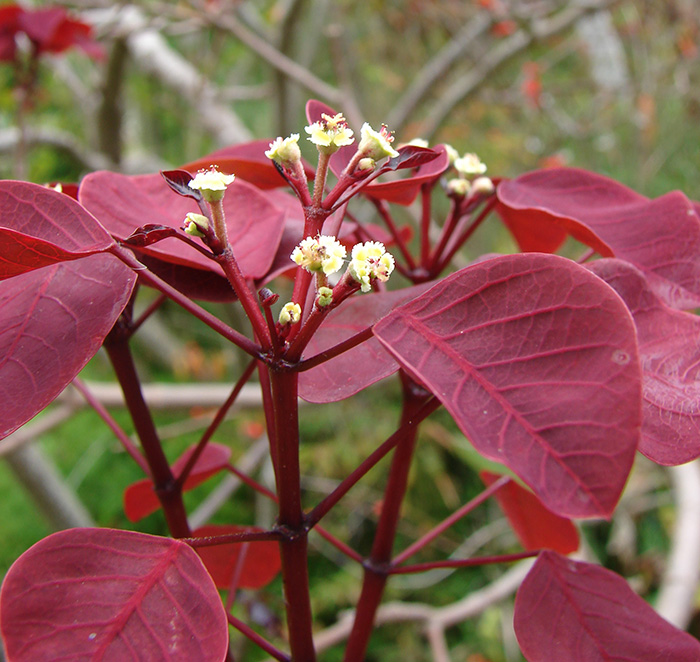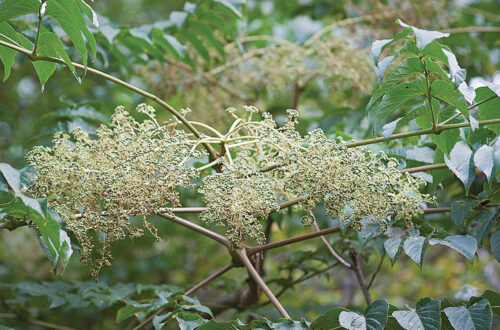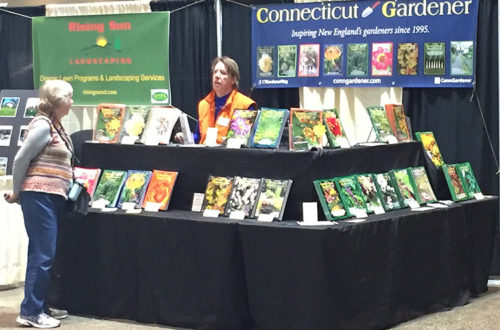Photo / Forest & Kim Starr, CC BY 3.0
Euphorbia cotinifolia (Tropical Smokebush)
By Steve Silk
PART I – ANNUALS IN THE SUMMER GARDEN
Pastels are pretty in spring, but come the dog days of summer, those dainty pinks, powdery blues, and pale primrose yellows look mostly milquetoast. They’re wimpy. Washed out.
When the July and August sun blazes mercilessly on the landscape, it’s time for gardeners to bring out the big guns – bright, saturated, full strength color and plenty of it.
We’re talking smoldering reds, fiery oranges, sunny yellows and maybe a deep, dark blue or two. Those unashamedly bold hues are just the antidote for summer heat and light so intense it threatens to burn away any hint of color that can’t hold up its head against the onslaught.
It’s no accident that tropical plants, by and large, feature color that might send timid gardeners scurrying. These brawling representatives of the plant kingdom bear their bold hues bravely, because they know they’ve got what it takes to stand up to sun. After all, what kinds of plants would know better than those that have adapted to thrive in those sweltering, sun-baked parts of the world where pastels are darn near extinct. I can take the hint.
In our part of the world, the garden’s not over by the Fourth of July. Or at least it shouldn’t be. But it is time to shift gears, to pump up the color palette and prepare for the season in the sun.
For me, that means – for the most part – adding annuals. I’m using the term loosely. In addition to botanical annuals (plants that, in a single season, sprout from seed, produce flowers, then seeds, and then wither and die), I’m including tender perennials (plants that would be hardy if we lived in, say, southern California) and tropicals (plants we might find in forest and field if we lived in Hawaii). If it grows, it’s fair game.
Annuals in Bays
There are all kinds of ways to add annuals to the garden. My basic method is to plan my mixed borders so that the trees, shrubs and perennials are arranged to allow open spaces or “bays” – swaths of soil that host a changing cast of characters over the season.
Typically, I plant these open bays in late fall with clumps of tulips. Then come spring, I enjoy the tulips, yank them when the show’s over and replant the vacant spots with annuals. In fall, the annuals come out – to be over-wintered indoors or fed to the compost heap – and in their place go some new tulips. And so the cycle starts all over again.
Using bays allows me to create a pleasing and sturdy framework of hardy plants which I can then decorate with more seasonal stuff. The upshot is that some parts of my garden are the same from year to year while other areas get reinvented several times a season. It keeps things lively.
For me gardens should always be about change and evolution. I don’t intend to ever be “done” with my garden. It will always be a work in progress. Using bays helps me keep things fresh and allows me to try new ideas and experiment with new color and plant combinations.
Annuals in Containers
Another fun way to add annuals to the border is to use containers.
I often plant up a few larger containers (16 inches in diameter or bigger) in monochromatic themes that explore the subtleties of a single color. Then when the need arises – maybe my bleeding hearts go dormant, a plant dies or a newly planted shrub needs company – I plug the pot into position and enjoy the results.
The advantage of using a single color scheme is that I can then select a color that suits the spot. A mixed container planted in a rainbow of colors might look attractive as a standalone, but some of the hues might clash with those of their in-ground neighbors in the border.
Annuals in the Border
Even if you didn’t plan ahead by prepping the border with seasonal planting bays or creating a few plug-and-play containers, annuals and tender perennials can brighten the season by getting a home wherever there’s a vacancy. That spot where the bleeding heart went dormant? You don’t need to plonk a container there, you can just plant something, carefully, at the edge of its roots, and let the new arrival take pride of place.
The idea is to add annuals wherever there’s space, but if you opt for that kind of more or less random approach it’s best to stick with a single type of annual, tropical or tender perennial. That way, you’ll be adding a thread of continuity to the garden rather than accentuating the sense of disorder a grab bag of bright colors might produce.
Wherever you set bold colors loose, consider the foliage. No, not the leaves of the plant in question, but the foliage of its neighbors. To avoid the sometimes strident effect of too much color – especially too much bold saturated color, you’ve got to think strategically. And that means using dark foliage.
Dark burgundy or bronzy foliage tempers bold color without diluting it too much. It takes the edge off. Plants such as nine bark ‘Diablo’ (Physocarpus opulifolius ‘Diablo’) or purple smoke bush (Cotinus coggygria ‘Purple Robe’ and similar cultivars) excel at reining in runaway hues.
Should you need to add some dark foliage to accommodate these intense summer colors, you can always use somber colored annuals such as dark colored coleus cultivars, or tropical smoke bush (Euphorbia cotinifolia).
Planting Tips
Wherever and however you elect to use boldly-colored annuals, there are few things to consider at planting time. First, these are likely to be heavy feeders, and you won’t go wrong providing them with a nutrient-rich environment.
One advantage of using seasonal planting bays is that you can easily make soil amendments twice a year.
When I plant tulips in fall, I amend each planting hole (I always dig larger holes that accommodate anywhere from 7 to 15 or so bulbs) with leaf mold, then top dress with another one- or two-inch deep layer of the stuff.
In late spring or early summer, the bulbs come out, the annuals go in and once again, I amend the planting holes. The result is good rich soil that hosts even heavy feeding tropicals. Plus the soil is moisture retentive, so watering is cut to a minimum.
In pots, I use my standard planting mix: one part quality potting soil, one part compost, and one part pine bark mulch. I stir it all up in a wheelbarrow and the result is that most elusive stuff of garden literature: rich, well-drained, moisture-retentive soil.
Even so, I feed my pots weekly with a drenching of water-soluble 20/20/20 fertilizer. That hopefully makes up for all of the nutrients that wash out of the bottom of the pot each time it’s watered.
With all those bold colors in the ground or in pots, you can coast through summer, enjoying the fruits,
or rather the flowers of your labors. And as an additional reward, those deep dark colors carry the color flag right on into fall. They’re just the ticket to harmonize with the deepening reds, oranges and yellows of autumn’s foliage.
PART II – FAVORITE ANNUALS
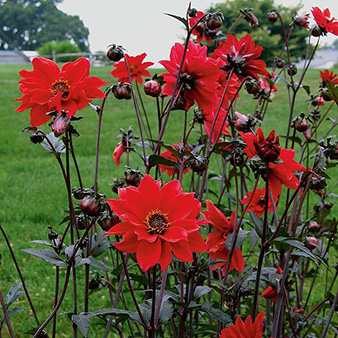
Dahlia ‘Bishop of Llandaff’
Dahlias
Why is it that dahlias aren’t in every garden? So often when I see them, they look like a bug collection, lined up in a special bed, staked and bound. What a waste! These plants are made for mixed borders.
Dahlias come in so many shapes, so many sizes, and so many colors that you should be able to find a great spot for at least one. Their flower power is exquisite, and if started early in protected conditions, they’ll add to the garden all season long – right up to frost.
Some, such as the ‘Bishop of Llandaff,’ are even all-in-one packages, with bright red flowers perched atop a tempering network of dark burgundy foliage. And this particular bishop must have been a something of a scofflaw because there’s a whole family of nearly equal beauties – the ‘Bishop’s Children’ – ready to leave their mark in the summer garden.
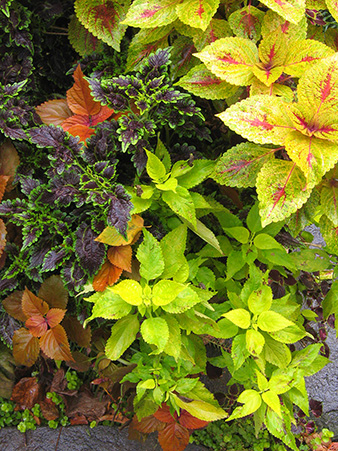
A collection of Coleus
Coleus (Species and Cultivars)
I’d crown coleus king of the summer garden. Like the dahlia, it’s a shape shifter: big leaves, little leaves, frilly leaves and paddle-shaped leaves. Some have scalloped edges, while others appear to have been trimmed with pinking shears.
Then there are the colors. Gosh, too many. There are super chartreuse or yellowy beauties like ‘Golda’, bold burgundys like ‘Burgundy Sun’ and rusty oranges like ‘Sedona.’
Some coleus are like multi-colored kaleidoscopes – coleus bring new meaning to the word variegated. Crazy ‘Kiwi Fern’ must have been invented in the psychedelic ’60s. My current fave is a wild one called ‘Skyfire.’ The list goes on and on. Try some out.
The notion that these are shade plants is a myth. As long as they get plenty of water, they’ll take nearly full sun – and their colors will be all the richer for it. Set some loose, and let their brazen colors rule.
Golden Trumpet (Allamanda cathartica)
I’m a recent convert to Allamanda. After seeing this vine all over Costa Rica, I just had to have one. The deep yellow of its flowers is utterly enchanting and the common name, golden trumpet, hints at the clarion call this vining wonder will sound in the garden.
Heavy feeding is a must for this Brazilian native, so give it a rich spot in the garden or fertilize regularly in a container. It will happily clamber over a structure if you take the time to weave its branches through something that will provide support, and carry its banner of rich deep yellow up toward the sky. For a nice big plant that will provide plenty of outdoor impact, overwinter Allamanda as a house plant. Easy peasy!
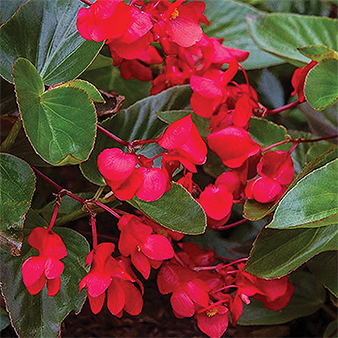
Begonia ‘Dragon Wing’
Begonias
Begonias don’t have to be boring. Bedding begonias aren’t the be all and end all of this diverse genus. Houseplant enthusiasts are acquainted with the splendiferous foliage of rhizomatous begonias, which are a great component for the outdoors in mixed containers too.
But the big blast comes from two relative newbies: Dragon Wing® (Begonia × hybrida ‘Dragon Wing’) and ‘Bonfire Begonia.’
Dragon Wing® Red will light a fire in a partly shaded spot. The beauteous winglike, dark-green leaves have a pleasing sheen and the plants are utterly tireless bloomers. They’ll rapidly shoot up to about 15 inches in height and broaden to a foot-and-a-half across, and every inch of that real estate is going to host flowers. And that red, by the way, does wonders at punching up pinks, so if you’ve got a pink area that needs a little more oomph, try a few of these.
‘Bonfire Begonia’ is also a tireless bloomer, but its hues run more to a traffic-stopping orangey red. This super container plant tumbles and billows at the same time, so it’s great at pot’s edge. I grew some under dark-leaved elephant ears (Colocasia ‘Black Magic’) last summer – Wowsa! – and plan to do it again this year.
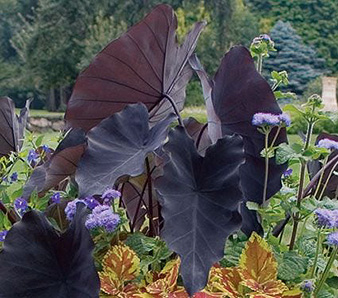
Colocasia ‘Black Magic’ (Elephant Ears)
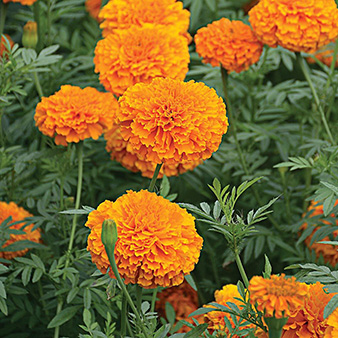
Tagetes erecta ‘Giant Orange’
Marigolds (Tagetes species)
I’m not afraid to admit I like marigolds Or, as my 10-year-old might say, I don’t like marigolds … I LOVE them!
Yes they’re common, yes they’re gaudy, but gosh, what’s not to like about these cheery, ferny-foliaged wonders that bloom their little heads off in showstopping shades of yellow, orange and smoky reds? They’re easy edgers, and planted along a path they serve as brightly glowing beacons that help direct traffic as dusk edges toward night. Sure they’re strident in spring, but plug a few in during summer and they look right at home.
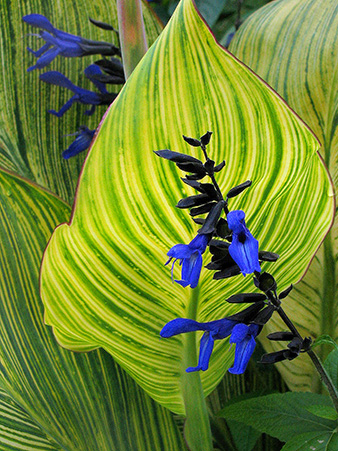
Salvia guaranitica ‘Black & Blue’ against Canna ‘Pretoria’
Salvias
How on earth can anyone have a garden without salvias? There’s one for every taste – rip-roaring reds, yummy yellows and bright, beautiful blues. There are tall ones and small ones. Plus, they’re hummingbird magnets. Any disposition on salvias would take far more time than we’ve got, so let’s limit our discussion to a quartet of tried-and-true garden workhorses.
Since true blue is always in short supply in the garden, we’ll start with two of that hue. First up is Salvia patens, available in several seed strains: Try 3-foot-tall ‘Blue Angel.’ This one’s a goody if you like sky blue, and who doesn’t? Plant some.
Also splendiferous is 4-foot-tall Salvia guaranitica ‘Black & Blue’ with its spires of deep blue flowers clasped by dark black bracts. The effect is eye-catching indeed, especially if you stage· it against the bright yellowy leaves of a Canna ‘Pretoria.’
Moving on to reds, I like cranberry-colored Salvia van houtteii, which puts on a show-stopping display in late season. It’s four feet tall and almost as big across, and decorated with a veritable cloudburst of bloom. Put this plant in the ground, rather than a container, for the best results. It looks grand consorting with blue asters, or dangling above purplish Sedum ‘Purple Emperor.’
For the fearless few – you know who you are – there’s a cultivar called ‘Dancing Flame’ with yellow variegation splashed on the leaves and red-orange flowers.
Tropical Smoke Bush (Euphorbia cotinifolia)
Tropical smoke bush isn’t about to win any prizes for its insignificant flowers, but I’d give it a big trophy for best-in-show burgundy foliage.
This shrubby euphorbia is reminiscent of a purple smokebush – hence the species name, which means smokebushlike foliage – but its leaves are oh-so-much darker, deeper and sultry colored than those of its hardy namesake.
I mentioned the need for using dark-foliaged plants to temper a runaway case of too much color, and this little number fills the bill very nicely indeed. There’s something nearly molten about its dark garnet hue that makes this an exceptional color companion for lava-hot oranges, fiery reds, or scorching yellows. Tropical smoke bush thrives in containers or in the ground until frost cuts it down.
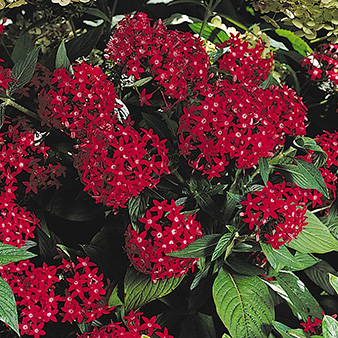
Pentas lanceolata
Star Flowers (Pentas species and cultivars)
Star flowers bring their own little galactic clouds of color to the garden, and the red ones (I don’t usually mess with the pink members of the clan) are easily tough enough to stand up to sun. And they can be real players in the garden.
I use them to create color echoes by pairing star flowers with any of the multitudes of coleus cultivars whose leaves bear that same exact shade of red. The relative heights are quite accommodating so the coleus forms a bright backdrop for the Pentas’s shimmering stars. In a pot or in the ground, together they make one heavenly body in the garden.
PART III – SELF-SOWING ANNUALS for LONG BLOOM
They say that Nature abhors a vacuum. And it’s true. Blank spots are also a bane of the gardener’s existence. Those yawning spaces – the gaps between maturing perennials and shrubs, or anywhere a few prized plants succumbed to frost heaves or winter wet – simply seem to invite trouble. Maybe they become a magnet for weeds, or just a threadbare spot in an otherwise carefully woven tapestry of flower and foliage. Whatever the case, they need filling, fast.
And for my money, there’s no easier, faster or more rewarding way than to plug those gaps with self-sowing annuals. First and foremost they are easy to establish. All you need do is scatter seed in earliest spring wherever you want them. From then, you’re set. Without any assistance from you, the seeds will germinate, grow and rise to fill their space with colorful flower or attractive foliage. And by virtue of being annuals, they’ll flower their hearts out, blooming far longer than 99 percent of their perennial partners. And as if that weren’t enough, they display the good graces to return year after year, often spreading to colonize more of the garden, though never in an invasive or troublesome way.
After more than five years of experimenting, I’ve discovered a handful of annuals with forms and colors that make especially good companions in mixed plantings rich with perennials. These happy-go-lucky plants contribute so much to my garden that I’d never be without them.
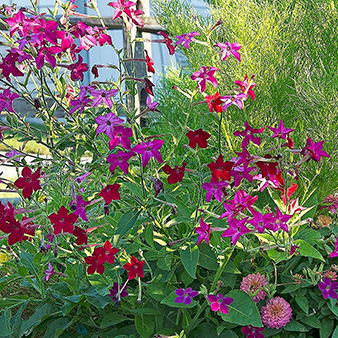
Nicotiana alata ‘Crimson Bedder’
Nicotianas for Form and Fragrance
Flowering tobaccos (Nicotiana spp.) are among my favorite self sowers. I don’t mean the diminutive, overbred plants developed for flower above all else, but rather their forerunners, the species varieties. They’ve got it all: fragrance, architectural form, soothing colors, and non-stop flowers. All nicotianas will grow best in sun, but will take some shade. The largest may need staking.
Unfortunately, few have all those attributes although Nicotiana sylvestris comes close. Long, trumpet-shaped white flowers, which are fragrant at night, appear like bursts of fireworks – atop 5 to 6 foot tall plants adorned with big, beefy leaves. This is one of the few annuals that looks good as a stand-alone plant. You just need one, though planting repeating groups of 3 to 5 offers more impact.
Its cousin, N. alata, is a slightly smaller version of same, and its flowers, though bedraggled by day, perk up at night to offer one of the most alluring fragrances in the entire plant kingdom.
Another nicotiana, N. langsdorffii, is the diplomat of the garden world. Its chartreuse floral bells combine handsomely with almost any other color, and can soothe border wars instigated by clashing colors. Just plant a few in the midst of any jarring combination of colors, and peace will prevail.
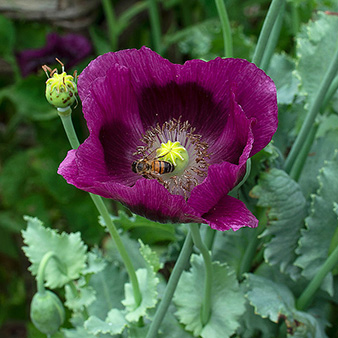
Papaver somniferum ‘Lauren’s Grape’
Poppy Perfection
Annual poppies liven up any garden. I’m most taken by the opium poppies (Papaver somniferum), which come in a range of color from pink to deep, burgundy reds and in forms from simple singles to peony-like doubles.
My current favorite is ‘Lauren’s Grape’ which bears elegant, single chalices the color of Welch’s grape juice. I think it blends especially well with other perennials. My friend Lauren Springer developed these in Colorado, where she planted every poppy seed available, whether they came atop a bagel or in a packet from Great Britain. When this color appeared, Lauren declared it “the apex of poppiedom.” I agree. She promptly tore out every other shade of poppy and spent 6 years roguing seedlings to develop a pure color strain.
The flowers are enhanced by the plant’s silvery, blue-green, sawtoothed foliage and the nodding seedpods that develop after the flowers have gone by in early summer. It self-sows true if grown away from other somniferums. All somniferums get a little ratty after flowering but I always leave plenty to generate seed.
Other annual poppies – Shirley poppies (P. rhoeas) and California poppies (Eschsholzia californica), tulip poppies (P. glaucum) and ladybird poppies (P. commutatum) – all bring bright color to the garden and are likely to self-sow in subsequent years.
Three for Beautiful Blues
Good blues are often hard to find in the garden, but self sowing annuals provide plenty. Superlative blues come from bush violet (Browallia americana), love-in-a-mist (Nigella damascena) and cornflower (Centaurea cyanus).
Bush violets are another of my all-time favorite annuals and a good performer in sun or shade in places wet or dry. They get about 2 feet tall and not quite as wide and are covered for months with small, magenta-kissed blue flowers with a white center. This is a far more subtle plant than the browallia
varieties available at garden centers for use in container planting. This almost perfect “filler” gracefully plugs any holes between maturing perennials. In fact, it does that so well, that I make certain to have plenty of holes waiting for the 150 or so plants I raise from seed each year.
Love-in-a-mist is right at home at the front edge of a border. It’s a looker all season long, from its frilly spring foliage to its intriguing, early summer silverdollar sized double flowers and, finally, to the maroon-striped, balloonlike seedpods which, when dried, are favored by flower arrangers. I like ‘Miss Jekyll Blue’ but flowers can be had in other colors. There’s a white form, ‘Miss Jekyll Alba,’ and a good mix of pinks, whites and blues called ‘Persian Jewels.’
Last but not least, there is cornflower, a lowly cornfield weed but nonetheless a source of delight wherever it raises its charming blue blossoms. As I said, this is a weed – it takes sun or at least some shade, and the 2-foot-or-so tall plants are drought tolerant to boot. Their superlative blue goes well with any color in the garden. I just broadcast seed partway back into the border and wait. Cornflowers are great for cutting, too.
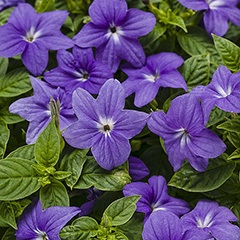
Browallia ‘Endless Illumination’ (Bush Violet)
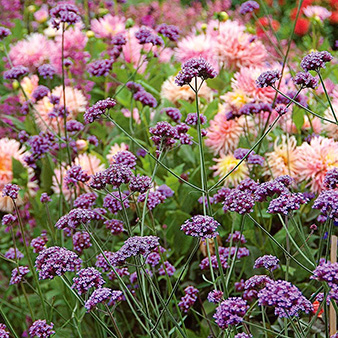
Verbena bonariensis
Two Plants To Put Up Front
Golden feverfew (Tanacetum parthenium ‘Aureum’) is a fine edging plant that pays the rent from spring to fall. Though you couldn’t ask for more white daisylike flowers than this compact little gem provides, its real asset is the 12 inch dome of chartreuse foliage, which looks good from one end of the season to the other. To me the flowers are a distraction. I’d shear them all off if it weren’t for the fact that I always want more plants. That makes me willing to let the flowers fly so they produce seed.
This is actually a perennial (to USDA Zone 5) and a plant that, after a few years, spreads to enough places to help knit the whole garden together. In the unlikely event it appears somewhere I’d rather it didn’t, I simply transplant it to another area. It looks great with both bush violets and love-in-a-mist. There’s no such thing as having too much golden feverfew.
Tall verbena (Verbena bonariensis) excels as a late summer see-through plant. With tall, spirelike stems and tufts of lilac-colored flowers, this South American native looks good anywhere and with anything. Its airy structure is such that the flowers almost seem to be floating in mid-air, even when plants are placed at the front of a border. While the plant may be insubstantial, its height is not – Verbena bonariensis easily reaches 5 feet. Though plants look good with anything, they really come alive when placed near shrubs with yellow or gold foliage, or against bold tropicals such as cannas. They also look great alongside yellow roses.
The fine seed is best mixed with sand for more even scattering. I send sprays of seed throughout borders wherever I want them. Just aim to create sweeping drifts. It’s also a plant that looks best repeated in several places in a garden. Don’t scrimp on seed and scatter plenty amongst perennials and shrubs. The basal clump of foliage doesn’t require much room and these plants have more impact in larger colonies.
To Establish Self Sowers, Prepare Site and Seed
Getting self-sowing annuals started is among the simplest of garden tasks: As soon as the snow melts in March or April (the earlier the better), I scatter seed wherever I want them to appear. It’s that easy.
Since these seeds self sow here, the seeds are used to getting through our winters, so sowing too early isn’t going to be a problem. Sowing too late might get you no flowers. By the way, I try to sow before a rainy stretch, it washes the seed into the soil (a good thing for those who just toss them out there) and gets the germination process going.
Though it’s not absolutely necessary, I always prepare a site for self-sowers by clearing the soil of debris then raking the spot smooth. Sometimes a spot might not be much bigger than the size of my hand, other times it might be 8 or more square feet. And make sure the site is right for your chosen seed, as most of these annuals, even the shade-tolerant ones, do better with more sun.
The next step is to prepare the seed. Larger seeds, those the size of a pinhead or larger, can be sown as is. But seeds of stalwarts such as flowering tobacco, golden feverfew and browallia, are so tiny they’re hard to sow in anything other than unwieldy clumps. For them, I put a couple tablespoons of sand into
a small bowl, mix in the seeds, then broadcast the sand/seed mix over the chosen site, thus ensuring that the seed is spread more evenly. Since I abandon all my self sowers to the ravages of nature, I expect massive attrition. So, I sow hundreds of seeds with the expectation that just a few will germinate and grow to maturity. Larger seed can be raked in so it has better soil contact, but I seldom bother.
Once the seed germinates, the challenge is distinguishing a desirable plant from an unwanted weed, which can be tough if the first few leaves of an emerging annual are unfamiliar. To help identify the good guys, you might sow a few seeds in a pot, watch what comes up and compare it with what’s out in the garden. Other strategies include surrounding planted areas with a tiny line of sand, or sowing into small furrows in the soil. Anything you can do to mark the places where seeds have been sown will help.
The next task is thinning out the seedlings, which are likely to spring up sparsely in some spots, profusely in others. Twice each spring – usually around late tulip time and again a month or so later – I thin the ranks of self-sown seedlings so they won’t be overcrowded. If unwanted seedlings have several sets of leaves, you might transplant them, otherwise toss them in the compost. Once that’s done, all that’s left is to sit back and enjoy the show. It will last for years, and thanks to the vagaries and unpredictability of self-sowers, it will be different every time.
Some Annuals Are Best Started Indoors
Everything but love-in-a-mist,
poppies and cornflowers can be started inside. The love-in-mist starts blooming kind of early and goes by, so it’s not worth the trouble of starting inside. Self-sown poppies bloom in early summer and resent transplanting. I usually get cornflower blooms in high summer.
Self-sown browallia and flowering tobacco won’t amount to much until about mid-August, so it’s worth starting a few indoors for an earlier display. I start these seeds 8 to 10 weeks before the last frost.
Seedlings, even indoors, need fertilizer at about half the recommended strength and frequency. Then flowers should start by mid-July and they’ll keep on making flowers through the first light frosts. The nicotianas produce more if deadheaded, or more accurately dead-branched, but it’s hardly necessary.
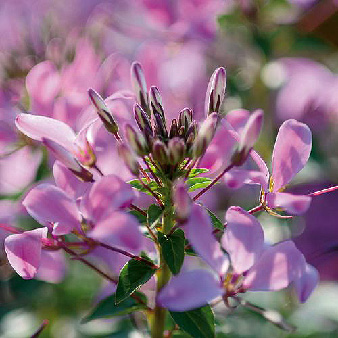
Cleome ‘Senorita Rosalita’
A Few Others to Try
These suggestions are just the tip of the self-sowing annual iceberg. It’s worth experimenting with almost any annual labeled as hardy. Not only do many of these sail through the first light frosts of fall, their seed is tough enough to withstand our winters and germinate and grow on even through the wildly fluctuating temperatures of spring.
Others worth trying include Perilla frutescens or Amaranthus cruentus or Amaranthus hypochondriacus selections for deep, dark foliage colors; cleomes for pinkish hues and an intriguingly different flower form; and Chinese forget-me-not (Cynoglossum amabile) for delicate blues.
Steve Silk is an accomplished garden designer, writer, lecturer and photographer who gardens in Farmington.

